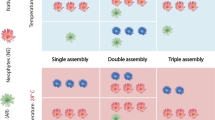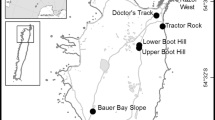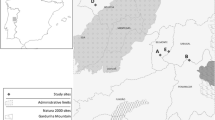Abstract
The vegetation of alpine tundra in the Changbai Mountains has experienced great changes in recent decades. Narrowleaf small reed (Deyeuxia angustifolia), a perennial herb from the birch forest zone had crossed the tree line and invaded into the alpine tundra zone. To reveal the driven mechanism of D. angustifolia invasion, there is an urgent need to figure out the effective seed distribution pattern, which could tell us where the potential risk regions are and help us to interpret the invasion process. In this study, we focus on the locations of the seeds in the soil layer and mean to characterize the effective seed distribution pattern of D. angustifolia. The relationship between the environmental variables and the effective seed distribution pattern was also assessed by redundancy analysis. Results showed that seeds of D. angustifolia spread in the alpine tundra with a considerable number (mean value of 322 per m2). They were mainly distributed in the low elevation areas with no significant differences in different slope positions. Effective seed number (ESN) occurrences of D. angustifolia were different in various plant communities. Plant communities with lower canopy cover tended to have more seeds of D. angustifolia. Our research indicated reliable quantitative information on the extent to which habitats are susceptible to invasion.
Similar content being viewed by others
References
Alpert P, Bone E, Holzapfel C, 2000. Invasiveness, invasibility and the role of environmental stress in the spread of non-native plants. Perspectives in Plant Ecology, Evolution and Systematics, 3(1): 52–66. doi: 10.1078/1433-8319-00004
Baret S, Maurice S, Le Bourgeois T et al., 2004. Altitudinal variation in fertility and vegetative growth in the invasive plant Rubus alceifolius Poiret (Rosaceae), on Réunion island. Plant Ecology, 172(2): 265–273. doi: 10.1023/B:VEGE. 0000026345.67250.d2
Bazzaz F, 1991. Habitat selection in plants. American Naturalist, 137: S116–S130.
Chang E, Jefferies R, Carleton T, 2001. Relationship between vegetation and soil seed banks in an arctic coastal marsh. Journal of Ecology, 89(3): 367–384. doi: 10.1046/j.1365-2745.2001.00549.x
Chou R, Vardy C, Jefferies R, 1992. Establishment from leaves and other plant fragments produced by the foraging activities of geese. Functional Ecology, 6(3): 297–301.
Chytrý M, Jarosik V, Pysek P et al., 2008a. Separating habitat invasibility by alien plants from the actual level of invasion. Ecology, 89(6): 1541–1553. doi: 10.1890/07-0682.1
Chytrý M, Maskell L C, Pino J et al., 2008b. Habitat invasions by alien plants: a quantitative comparison among Mediterranean, subcontinental and oceanic regions of Europe. Journal of Applied Ecology, 45(2): 448–458. doi: 10.1111/j.1365-2664.2007.01398.x
Colautti R I, Grigorovich I A, MacIsaac H J, 2006. Propagule pressure: a null model for biological invasions. Biological Invasions, 8(5): 1023–1037. doi: 10.1007/s10530-005-3735-y
Di Vittorio C T, Corbin J D, D’Antonio C M, 2007. Spatial and temporal patterns of seed dispersal: an important determinant of grassland invasion. Ecological Applications, 17(2): 311–316. doi: 10.1890/06-0610
Forcella F, Wood J, Dillon S, 1986. Characteristics distinguishing invasive weeds within Echium (Bugloss). Weed Research, 26(5): 351–364. doi: 10.1111/j.1365-3180.1986.tb00718.x
Foster B L, Dickson T L, Murphy C A et al., 2004. Propagule pools mediate community assembly and diversity ecosystem regulation along a grassland productivity gradient. Journal of Ecology, 92(3): 435–449. doi: 10.1111/j.0022-0477.2004.00882.x
Gadgil M, 1971. Dispersal: population consequences and evolution. Ecology, 52(2): 253–261. doi: 10.2307/1934583
Halloy S R P, Mark A F, 2003. Climate-change effects on alpine plant biodiversity: a New Zealand perspective on quantifying the threat. Arctic, Antarctic, and Alpine Research, 35(2): 248–254. doi: 10.1657/1523-0430(2003)035[0248:CEOAPB] 2.0.CO;2
He H, Hao Z, Larsen D R et al., 2002. A simulation study of landscape scale forest succession in northeastern China. Ecological Modelling, 156(2): 153–166. doi: 10.1016/S0304-3800(02)00104-7
Hejda M, Pyšek P, Pergl J et al., 2009. Invasion success of alien plants: do habitat affinities in the native distribution range matter? Global Ecology and Biogeography, 18(3): 372–382. doi: 10.1111/j.1466-8238.2009.00445.x
Huang Xichou, Li Chonghao, 1984. An analysis on the ecology of alpine tundra landscape of Changbai Mountains. Acta Geographica Sinica, 39(3): 285–297. (in Chinese)
Humphries S E, Groves R H, Mitchell D S, 1991. Plant Invasions of Australian Ecosystems: A Status Review and Management Directions Report To: Australian National Parks and Wildlife Service. Sydney: Australian National Parks and Wildlife Service, 160–165.
Jongman R H, Ter Braak C J, van Tongeren O F, 1995. Data Analysis in Community and Landscape Ecology. London: Cambridge University Press.
Kalamees R, Zobel M, 2002. The role of the seed bank in gap regeneration in a calcareous grassland community. Ecology, 83(4): 1017–1025. doi: 10.1890/0012-9658(2002)083[1017: TROTSB]2.0.CO;2
Körner C, 2003. Alpine Plant Life: Functional Plant Ecology of High Mountain Ecosystems. Heidelberg: Springer Verlag.
Krinke L, Moravcová L, Pysek P et al., 2005. Seed bank of an invasive alien, Heracleum mantegazzianum, and its seasonal dynamics. Seed Science Research, 15(3): 239–248. doi: 10.1016/j.ppees.2008.03.001
Lepš J, Šmilauer P, 2003. Multivariate Analysis of Ecological Data Using CANOCO. London: Cambridge University Press
Li Youzhi, Huang Jishan, Zhu Jiehui, 2007. Effects of light and temperature on seed germination and seedling growth of Deyeuxia angustifolia. Journal of Hunan Agricultural University (Natural Sciences), 33(2): 187–190. (in Chinese)
Li Y, Zhang C, Xie Y et al., 2009. Germination of Deyeuxia angustifolia as affected by soil type, burial depth, water depth and oxygen level. Mitigation and Adaptation Strategies for Global Change, 14(6): 537–545. doi: 10.1007/s11027-009-9172-y
Lockwood J L, Cassey P, Blackburn T, 2005. The role of propagule pressure in explaining species invasions. Trends in Ecology & Evolution, 20(5): 223–228. doi: 10.1016/j.tree.2005.02.004
Marco D E, Páez S A, 2000. Invasion of Gleditsia triacanthos in Lithraea ternifolia montane forests of central Argentina. Environmental Management, 26(4): 409–419. doi: 10.1007/s 002670010098
McDougall K L, Khuroo A A, Loope L L et al., 2011. Plant Invasions in Mountains: global lessons for better management. Mountain Research and Development, 31(4): 380–387. doi: 10.1659/MRD-JOURNAL-D-11-00082.1
Molau U, Larsson E L, 2000. Seed rain and seed bank along an alpine altitudinal gradient in Swedish Lapland. Canadian Journal of Botany, 78(6): 728–747. doi: 10.1139/cjb-78-6-728
Muñoz A A, Cavieres L A, 2008. The presence of a showy invasive plant disrupts pollinator service and reproductive output in native alpine species only at high densities. Journal of Ecology, 96(3): 459–467. doi: 10.1111/j.1365-2745.2008.01361.x
Nathan R, Muller-Landau H C, 2000. Spatial patterns of seed dispersal, their determinants and consequences for recruitment. Trends in Ecology & Evolution, 15(7): 278–285. doi: 10.1016/S0169-5347(00)01874-7
Pauchard A, Alaback P B, 2004. Influence of elevation, land use, and landscape context on patterns of alien plant invasions along roadsides in protected areas of Sout-Central Chile. Conservation Biology, 18(1): 238–248. doi: 10.1111/j.1523- 1739.2004.00300.x
Pauchard A, Kueffer C, Dietz H et al., 2009. Ain’t no mountain high enough: plant invasions reaching new elevations. Frontiers in Ecology and the Environment, 7(9): 479–486. doi: 10.1890/080072
Quiroz C L, Choler P, Baptist F et al., 2009. Alpine dandelions originated in the native and introduced range differ in their responses to environmental constraints. Ecological Research, 24(1): 175–183. doi: 10.1007/s11284-008-0498-9
Richardson D M, Kluge R L, 2008. Seed banks of invasive Australian Acacia species in South Africa: role in invasiveness and options for management. Perspectives in Plant Ecology, Evolution and Systematics, 10(3): 161–177. doi: 10.1016/j. ppees.2008.03.001
Scherff E, Galen C, Stanton M, 1994. Seed dispersal, seedling survival and habitat affinity in a snowbed plant: limits to the distribution of the snow buttercup, Ranunculus adoneus. Oikos, 69(3): 405–413. doi: 10.2307/3545853
Theoharides K A, Dukes J S, 2007. Plant invasion across space and time: factors affecting nonindigenous species success during four stages of invasion. New Phytologist, 176(2): 256–273. doi: 10.1111/j.1469-8137.2007.02207.x
Titus J H, del Moral R, 1998. Seedling establishment in different microsites on Mount St. Helens, Washington, USA. Plant Ecology, 134(1): 13–26. doi: 10.1023/A:1009765502741
Vilà M, Gimeno I, 2007). Does invasion by an alien plant species affect the soil seed bank? Journal of Vegetation Science, 18(3): 423–430. doi: 10.1111/j.1654-1103.2007.tb02554.x
Wei J, Jiang P, Yu D et al., 2007. Distribution patterns of vegetation biomass and nutrients bio-cycle in alpine tundra ecosystem on Changbai Mountains, Northeast China. Journal of Forestry Research, 18(4): 271–278. doi: 10.1007/s11676-007-0055-3
Williamson M H, Fitter A, 1996. The characters of successful invaders. Biological Conservation, 78(1): 163–170. doi: 10.1016/0006-3207(96)00025-0
Wilson J R, Dormontt E E, Prentis P J et al., 2009. Something in the way you move: dispersal pathways affect invasion success. Trends in Ecology & Evolution, 24(3): 136–144. doi: 10.1016/j.tree.2008.10.007
Witkowski E, Wilson M, 2001. Changes in density, biomass, seed production and soil seed banks of the non-native invasive plant, Chromolaena odorata, along a 15 year chronosequence. Plant Ecology, 152(1): 13–27. doi: 10.1023/A:1011409004004
Zheng D, Wallin D O, Hao Z, 1997. Rates and patterns of landscape change between 1972 and 1988 in the Changbai Mountain area of China and North Korea. Landscape Ecology, 12(4): 241–254. doi: 10.1023/A:1007963324520
Zong Shengwei, Wu Zhengfang, Du Haibo, 2013a. Study on climate change in alpine tundra of the Changbai Mountain in growing season in recent 52 years. Arid Zone Research, 30(1): 41–49. (in Chinese)
Zong Shengwei, Xu Jiawei, Wu Zhengfang, 2013b. Analysis on the process and impacts of deyeuxia angustifolia invasion on the alpine tundra, Changbai Mountain. Acta Ecologica Sinica, 34(23): 6837–6846. (in Chinese)
Zong Shengwei, Xu Jiawei, Wu Zhengfang, 2013c. Investigation and mechanism analysis on the invasion of Deyeuxia. angustifolia to tundra zone in western slope of Changbai Mountain. Journal of Mountain Science, 31(4): 448–455. (in Chinese)
Author information
Authors and Affiliations
Corresponding author
Additional information
Foundation item: Under the auspices of Special Fund of National Seismological Bureau, China (No. 201208005), Doctorial Innovation Fund of Northeast Normal University (No. 10SSXT133, 2412013XS001), National Natural Science Foundation of China (No. 41171038, 41171072, 41101523), Doctoral Fund of Ministry of Education of China (No. 20120043110014)
Rights and permissions
About this article
Cite this article
Zong, S., Xu, J., Dege, E. et al. Effective seed distribution pattern of an upward shift species in alpine tundra of Changbai Mountains. Chin. Geogr. Sci. 26, 48–58 (2016). https://doi.org/10.1007/s11769-015-0775-9
Received:
Accepted:
Published:
Issue Date:
DOI: https://doi.org/10.1007/s11769-015-0775-9




